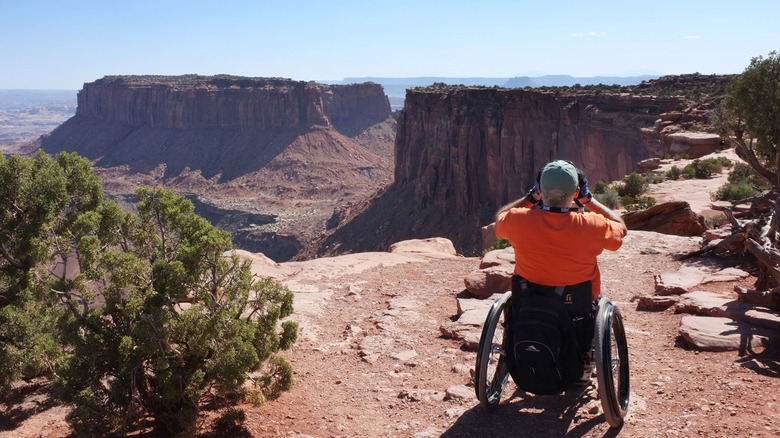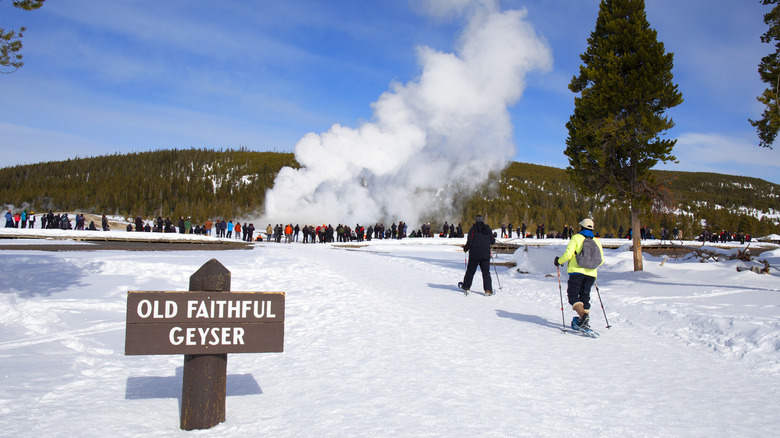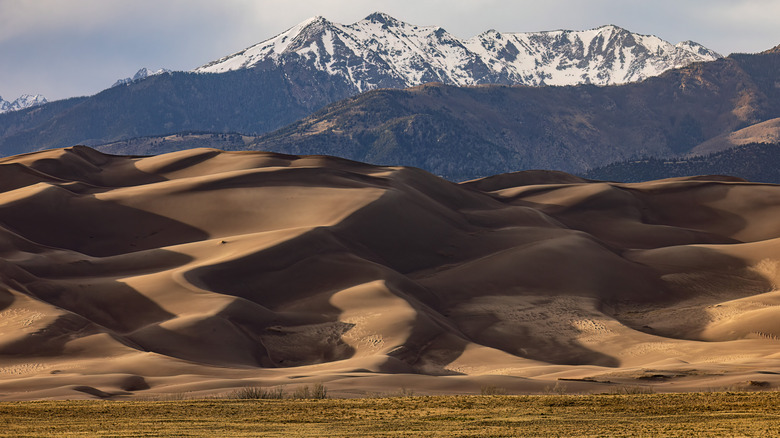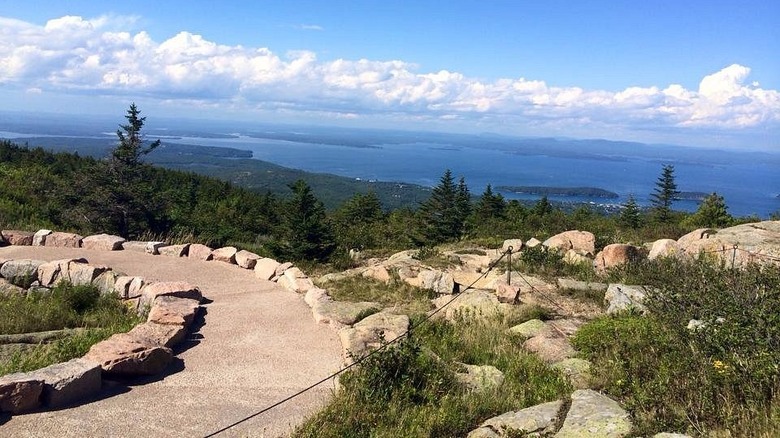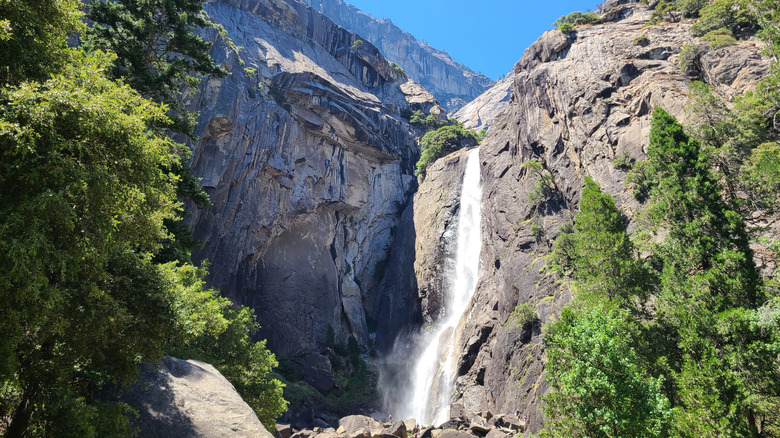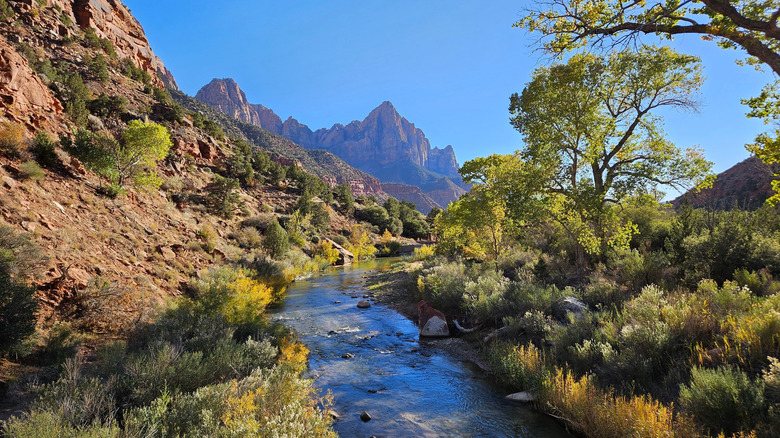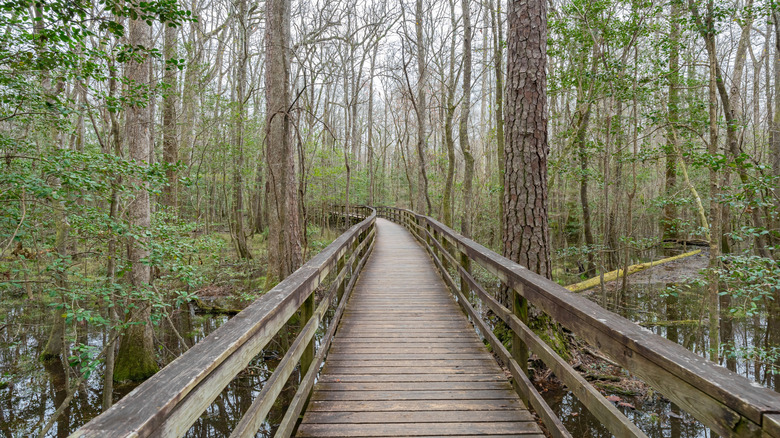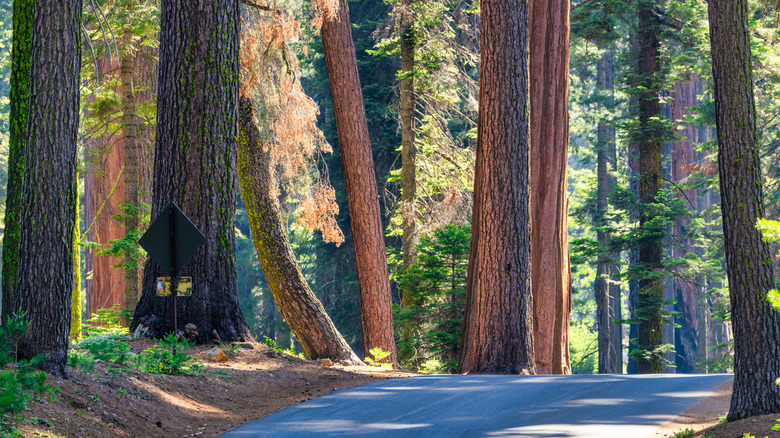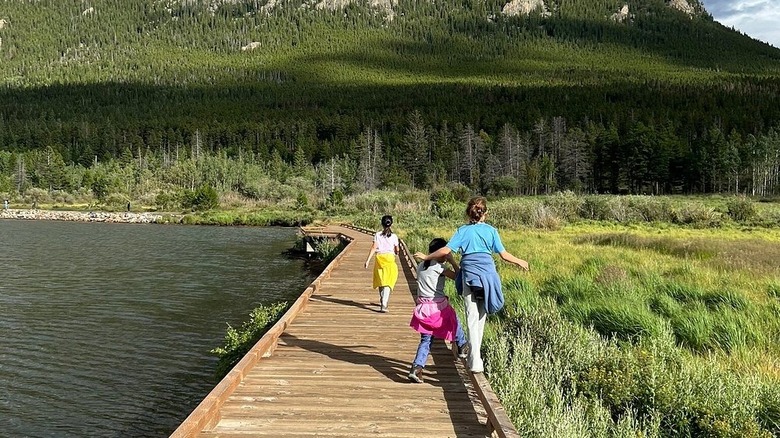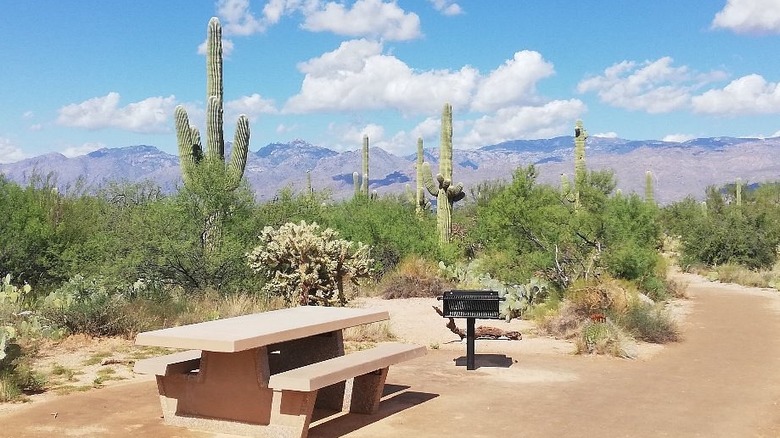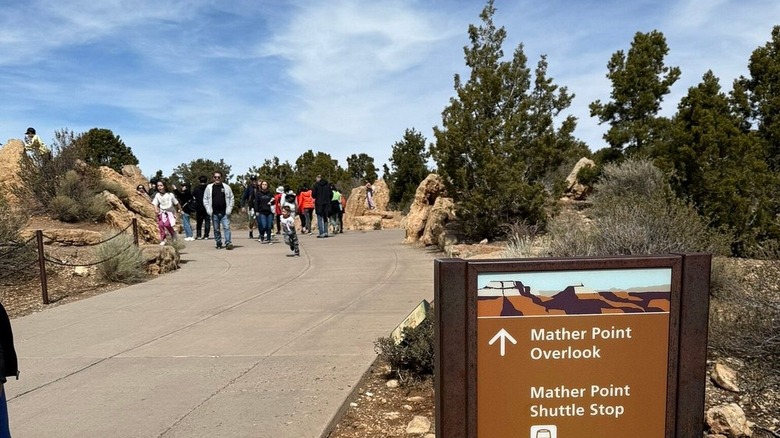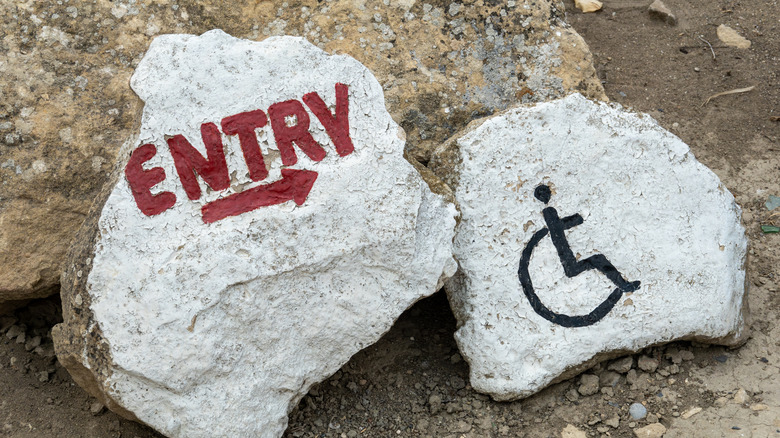The Most Accessible National Park Hikes In The US, According To Research
The U.S. National Park system teems with natural beauty. Across more than 85 million acres and 433 NPS-administered areas, the American outdoors is a bafflingly complex and sprawling thing that continues to excite and inspire people from around the world. Hiking is frequently at the top of visitors' minds. Some of the most challenging national park hikes involve grueling days of extreme elevation change. On the other hand, scenic routes and user-friendly trails will be more to the speed of the average outdoor enthusiast. However, even some of the lightest physical requirements still exclude millions of Americans.
More than 42 million Americans live with disabilities, as of data available from the 2021 census (via Pew Research Center). Hiking isn't always in the cards for these travelers without additional accommodations to support their needs. Fortunately, the National Park Service publishes plenty of resources to help plan a trip to the nation's parks with accessibility requirements in mind. Moreover, a notable number of hiking trails are purpose-built to provide for those with specialized needs.
Upper Geyser Basin Trail, Yellowstone National Park
The Upper Geyser Basin Trail features a mix of paved road and wooden boardwalk sections. The 3.5-mile out-and-back path is essential for visitors looking to catch a glimpse of Yellowstone National Park's geothermal activity. In other words, if you want to see Old Faithful erupting, heading off on this journey is a must. Accessible walkways can be found leading out to the Old Faithful Geyser from Yellowstone's parking areas, and a total elevation gain of 115 feet across the span makes it a fairly easy path to traverse.
Visitors needing a wheelchair can rent or loan equipment from the park's visitor centers, and beach wheelchairs are available, too. This also makes a trip down to the shores of Yellowstone Lake an option for those requiring mobility assistance. The geyser, however, is perhaps one of the most consistent draws for tourists visiting Yellowstone's iconic landscape. Old Faithful erupts essentially every 90 minutes without fail, and the trek into its basin is a majestic voyage through the densest concentration of geyser activity anywhere on Earth.
Meandering your way along this trailhead's paths brings you alongside a variety of other geological features that can really slow you down. The Morning Glory hot spring pops with vivid color, and other eruptors like the Daisy, Castle, and Riverside geysers can be tracked, too. This gives you plenty of time to get into position ahead of the next event.
Great Sand Dunes National Park
Colorado's underrated Great Sand Dunes National Park offers a landscape with its own unique DNA. Much of the park is a sprawling singularity, although definitive features like Medano Creek and other, non-dune elements come into the picture. Great Sand Dunes was designated a national monument, but it was reclassified as a national park in 2004 and expanded. The dune field covers an area of about 30 square miles. Outside of dedicated campsites (like NPS's Piñon Flats Campground), visitors with a backcountry permit and a willingness to brave the dunes can set up camp anywhere they like beyond the day-use area.
All this sounds phenomenal for an outdoor adventurer with full mobility, but those requiring accessibility support might wonder how any of this pertains to them. Seven hundred and fifty-foot tall sand dunes are a majestic sight, but don't worry if you can't make the hike out to see them. Fortunately, less mobile adventurers can also tackle the dunes in style. The whole environment is ripe for exploration, and with one of the balloon tire wheelchairs offered by the National Park Service in the visitor centers, rolling over the sandy landscape is entirely possible.
Further, there's an accessible mat running from the parking area to Medano Creek that makes navigating this part of the park a reality, even for those with traditional wheelchairs. The park features both three-wheeled and four-wheeled variants of the balloon tire chairs. Both can be difficult to push through, particularly soft sand, so a strong traveling partner is a must.
Jesup Path and Hemlock Path Loop, Acadia National Park
Located in Maine's Acadia National Park, the Jesup Path and Hemlock Path Loop runs along a figure-eight trail that's largely flat across the entire duration. The 1.5-mile round-trip trek features a boardwalk, wooden footbridge, wide gravel road, and pullouts that make for convenient stopping points. The entirety of the boardwalk is wide enough for a wheelchair to traverse the trail confidently, and the flat grade offers an enjoyable ride.
The trail isn't just characterized by its user friendliness and accessibility traits, though. Cutting through a white birch forest, the hiking trails wind their way across a beautiful, boggy landscape that will have you gasping in awe at every turn. In the spring or summer, you'll be treated to a dazzling green hue bursting with growth and new life. As the weather cools and autumn sets in, Acadia National Park features prominently as one of America's best fall road trip routes to catch blazing red, yellow, and orange leaves.
This part of the park, the Sieur de Monts, is also a phenomenal place to engage in birdwatching. It survived the Fire of 1947 (which burned approximately 17,000 acres of the island, including over 10,000 acres inside the park) and stands as an old stalwart in this beautiful portal away from the demands of modern life. The result is an accessibility-friendly park that holds plenty of great treasures within its confines.
Lower Yosemite Fall Trail, Yosemite National Park
Yosemite National Park is a favorite for campers, hikers, and adventure climbers. It is home to a bevy of fantastic cliffs that deliver exciting vertical routes for those of all skill levels (including the intense El Capitan). The extremes of Yosemite make for a stunning visual backdrop, making the sprawling landscape inviting even for those who will remain planted on the ground. Wheelchair users have options available to them, specifically.
The Lower Yosemite Fall Trail is one such wheelchair accessible choice. The trail extends along a 1-mile looping course that rises a total of 50 feet in elevation gain. The pathway is paved, allowing wheelchair users to make complete use of it. There's a viewpoint at the end, and mist from the falls above gently permeates the air. All along the path, hikers will find rest points that make for a leisurely jaunt through one of the most pristine and iconic wildlands in America.
Pa'rus Trail, Zion National Park
Paved trail surfaces are commonplace among national park hikes designed with accessibility in mind. The Pa'rus Trail in Zion National Park is one such option that hikers with mobility requirements can take full advantage of. The trail is paved and follows a 3.2-mile out-and-back route. Along the way, it connects the Zion Canyon Visitor Center and Canyon Junction while following the flow of the Virgin River. You'll encounter incredible views of the Watchman, a sandstone mountain that rises out of the Utah desert in spectacular fashion.
The trail is explicitly wheelchair-accessible and wide enough for comfortable travel along the gorgeous valley scenery. Moreover, it features an elevation gain of roughly 141 feet, making it reasonably manageable even for traditional wheelchair users who will propel themselves along its course. It's a great option for those seeking to take in the sunset or stare at the sky and view the heavens above long after the darkness has fully set in.
Boardwalk Loop Trail, Congaree National Park
Congaree National Park takes accessibility seriously. The most accessible hiking course is the Boardwalk Loop Trail, a 2.6-mile loop hike that's well shaded under supremely scenic old-growth hardwood forest. The boardwalk surface is ideal for a hiker requiring support and a steady surface. It consists of low sections and elevated areas that make traversing the trail possible even when the national park is flooded. This happens frequently as the boardwalk loops through a portion of Congaree's floodplain.
Visitors will come into contact with many birds and other wildlife species on their travels along the loop that makes its way toward Weston Lake and back again. Great blue heron, deer, otter, and even alligators are found in abundance throughout the woods, delivering a fascinating landscape even for repeat visitors. Those needing additional support can borrow a wheelchair from the Harry Hampton Visitor Center for free during the park's hours of operation. They can also access passes that can be used in Congaree National Park and elsewhere. The Access Pass is a free, lifetime pass covering over 2,000 recreation sites and is offered to permanently disabled American citizens and residents.
Big Trees Trail, Sequoia National Park
Big Trees Trail is a paved and boardwalk-equipped loop that stretches 0.75 miles through Sequoia National Park. It encircles Round Meadow and features a flat landscape that won't be too taxing on users of wheelchairs and walkers who may need some additional support. Benches can be found throughout the trail and near Hazelwood Meadow Trail, which brings hikers through a different section of the park's towering sequoia tree grove. Visitors with disability placards can park right next to the trailhead. Temporary credentials can be obtained from the park's visitor centers for those who need a nearby parking amenity but don't have the required tag.
Along the trail, you can expect to see animals like yellow-bellied marmots and even bears. The trail features a gentle sloping path and can be found within a mile of the Giant Forest Museum. You can learn more about the giant sequoia trees that have grown in the region for thousands of years. Their trunks are surprisingly fire resistant, but sequoias can only be found in roughly 70 groves dotting the western edge of the Sierra Nevada range in California. That makes them a unique sight, and one that wheelchair users don't have to worry about finding appropriate accommodations to visit.
Coyote Valley Trail, Rocky Mountain National Park
The Coyote Valley Trail in Rocky Mountain National Park is an oddity within the overarching theme of the region. Much of the landscape is characterized by sharp elevation gain and a significant starting height that can make even easy-rated trails an interesting challenge. There are 58 peaks that meet the definition of a 14er in Colorado alone (rising about 14,000 feet and delivering enhanced preparation requirements and skill necessities to climb). In the park, there are over 60 12ers, and roughly 33% of the entire landscape of the park lies at elevation levels above the tree line. The result is a place that might immediately feel inhospitable to a hiker requiring accessibility features.
But Coyote Valley Trail breaks the mold and provides a fantastic day out for wheelchair users and others hiking in this stunning amphitheater of Goliath mountain summits. The elevation gain across the 1-mile out-and-back path is just 13 feet. It's a wide trail featuring solid stroller and wheelchair accessibility chops, sitting at an elevation of around 8,800 feet. It also features a packed gravel surface and crosses over the Colorado River as it makes its way south toward the Grand Canyon, 1,400 miles away.
Desert Discovery Trail, Saguaro National Park
The Desert Discovery Trail is a paved, 0.5-mile trail that traverses Arizona's Sonoran Desert in Saguaro National Park. Along the route, you'll come into contact with the park's namesake, the iconic, seemingly improbably tall giant saguaro cactus. On your journey, you'll encounter interpretive signs posted along the way that point out important elements of the landscape's unique desert ecology. While it might look desolate beyond the trail, it's an intricately balanced ecosystem that maintains itself. Benched and shaded areas can be found along the route, allowing walkers and wheelchair users to take a break whenever necessary.
Beyond the trail, you'll take in grand views of the Baboquivari and Quinlan Mountains to the southwest and west, respectively, and gawk at the Avra Valley that expands beyond. You'll encounter slowly rolling hills along the trail (featuring a perhaps barely perceptible 16-foot elevation gain) and out in the distance. The path exudes a certain ambiance; it shines gloriously as the sun begins to set over the sprawling desert vista. It's easy to find, right off the road just north of the Red Hills Visitor Center. As well, the trail begins just a stone's throw from its starting point.
The Trail of Time, Grand Canyon National Park
The Trail of Time chronicles the truly titanic formation of the Grand Canyon. Each meter of the trail's 2.83-mile length represents 1 million years of silently shifting geological history. Plaques along the way describe some of the forces that took place during important phases of the canyon's slow and methodical carving of the desert's cliff faces. The trail is designed as an interpretive and immersive experience, and it's suited well to those with accessibility needs alongside walkers who may not require additional services. The trail starts at the Yavapai Geology Museum and meanders gently toward the Grand Canyon Village and eventually toward Hermits Rest.
The trail is a paved affair with an essentially flat expanse, making it readily accessible for those using wheelchairs or other accessibility aids. It opened in 2010 and seeks to make visitors think about the awesome might of the planet they inhabit. Overlooking the canyon's potent landscapes, the trail serves as a stark reminder of how powerful the forces of nature are in comparison to humankind.
Methodology
The trails and national parks highlighted here all share some key commonalities. Information from resources like All Trails helped contextualize what visitors can expect. Details directly from the National Park Service underpinned the examination, however. Further contextualization was sourced from accounts by travelers who have traversed these trails in the past and specifically by hikers with accessibility needs.
Most of the hikes featured here are paved or dominated by boardwalks. They also have very slight or even non-existent elevation gains along their paths. Most are short in comparison to the moderate or difficult hikes found within the larger national park landscape that each one inhabits. Additionally, some of these hikes exhibit core feature inclusions that enable them to be accessibility-ready. For instance, without the balloon wheelchairs offered by rangers, Great Sand Dunes National Park would be unfriendly territory for wheelchair users.
